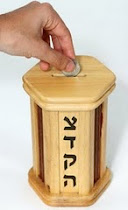Thursday, September 25, 2008
The Previous Rebbe taught:
Chassidus and Chassidim are a “tree of life.” The tree contains the roots, which are connected to the koach ha’tzome’ach (the potential for plant life found in the earth that sustains the roots), the trunk of the tree, and the branches. The roots and the trunk enable the branches to receive their vitality and produce various fruit.
In the Chassidic tree of life, the Rebbeim are the roots, the trunk is Chassidus, and the branches are Chassidim.
Every Chossid is a branch of the tree of life. The roots and the trunk enable Chassidim, who are the branches, to receive an internally-felt vitality (“chayus pnimi”) to produce fruit. “What are the fruit? Mitzvos (Sotah 46a)”—performing a Mitzvah with an internally-felt vitality.
Sefer HaMa’amarim 5708, p. 262
Comments:
1. This analogy expresses nicely the concept discussed in the HaYom Yom of 24 Sivan, where it is written:
You ask how can you be bound (mekushar) to me when I do not know you personally. ... The true Hiskashrus (bond) is formed by studying Torah. When you study my Ma’amorim, read the Sichos and associate with those dear to me—the Chassidic community and the Temimim—in their studies and farbrengens, and you fulfill my request regarding reciting Tehillim and observing Torah-study times—in this is the Hiskashrus.
It is true that the Previous Rebbe lists several other criteria for establishing Hiskashrus, but the first one is studying Chassidus, about which he says, “The true Hiskashrus is created by studying Torah.” He then lists other things which are also necessary for Hiskashrus; however, 1. they are listed second; and 2. it is not written that those methods create “true Hiskashrus,” only “the Hiskashrus.”
The above analogy (between roots, trunk, and branches and the Rebbeim, Chassidus, and Chassidim respectively) fits nicely with this, for it conveys the concept that the main role of the Rebbeim is to reveal Chassidus, and thus the most crucial way of connecting with them is by studying and internalizing their teachings.
It should be noted that this analogy for the Rebbe-Chossid relationship was specifically said concerning the relationship of the Chabad Rebbeim and their Chassidim. However, this principle may not be relevant to non-Chabad Chassidim, whose relationship with their Rebbeim may not hinge upon in-depth study of the Torah of their Rebbeim, or at least not to this degree. This difference can perhaps also be inferred from the teaching in this post, in which a non-Chabad Rebbe also describes the relationship between the Tzaddik and his followers as one unit—he uses the analogy of the limbs of a body—but does not emphasize the role of the Torah that the Tzaddik teaches as crucial in establishing this bond.
2. As is known, in pnimiyus (the inner aspect) and chitzoniyus (the external aspect) there are many levels. What is pnimiyus compared to a lower level is chitzoniyus when compared to a higher one (see Zohar 1:20a, discussed in Toras Menachem 5711, Vol. 1, p. 208).
For a Chabad Chossid the relationship with the Rebbe and with all of the Rebbeim of Chabad is a very deep one. They are the root of his Neshama. They guide him in reaching the profound intellectual understanding of Hashem’s greatness revealed in Chassidus. But the goal of this relationship is something still deeper: Bringing the Jew to become truly inspired in his avodas Hashem (divine service). This is attained in a far deeper manner through the relationship with the Rebbeim and the study of Chassidus than without it.
This seems to be really another way of expressing the core Chabad idea that the purpose of Haskalah (scholastic achievement in grasping the complex abstract levels of G–dliness explained in Chabad Chassidus) is Avodah (changing one’s middos, character traits, and inspiring one’s actual conduct).
Perhaps this can also be connected with what Chassidus says in several places (for example, in Sefer HaMa’amarim 5671, p. 145 and in Hagahos L’dibbur Ha’maschil Posach Eliyahu 5658, p.11) that the main purpose of a fruit tree is to grow fruit, and therefore the entire tree is named for the fruit that it produces—for example, a fruit tree.
Perhaps the same can be said in this case: The purpose and end-goal, of the Rebbe-Chossid relationship that Hashem established is the fruit—that the Chossid reach true inspiration in his avodas Hashem. This is the main thing.








